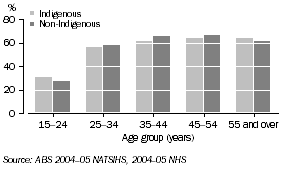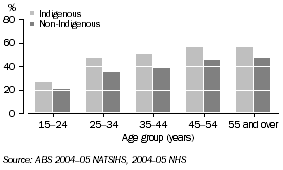OVERWEIGHT/OBESITY
In Australia and worldwide, the prevalence of overweight/obesity has been increasing markedly over the last two decades (AIHW 2006b). Obesity increases the risk of developing a range of health problems including Type 2 diabetes, cardiovascular disease, high blood pressure, osteoarthritis and certain cancers. As a single risk factor, high body mass was the second leading cause of the burden of illness and injury among Indigenous Australians in 2003, accounting for 11% of the total burden of disease and 13% of all deaths (Vos et al 2007).
In 2004-05, of those who reported their height and weight, 38% of Indigenous people aged 15 years and over were a healthy weight, 28% were overweight and 29% were obese (for more information on the calculation of Body Mass Index (BMI) see the Glossary). Overall, more than half (57%) of Indigenous people aged 15 years and over were overweight or obese. Between 1995 and 2004-05, rates of overweight/obesity among Indigenous people aged 15 years and over in non-remote areas increased from 48% to 56%.
In 2004-05, the rates of overweight/obesity were higher in older age groups, ranging from 37% of people aged 15-24 years to 74% of people aged 55 years and over. Overall, the rates of overweight/obesity were similar for both Indigenous males (58%) and females (55%).
Overweight/obesity was associated with poorer self-assessed health among Indigenous people in 2004-05. Indigenous people aged 15 years and over who were overweight/obese were more likely than those who were a healthy weight to report their health as fair or poor (25% compared with 16%) and were less likely to report their health as excellent or very good (39% compared with 51%).
Similarly, Indigenous people aged 35 years and over who were overweight/obese were more likely than those who were a healthy weight to report diabetes/high sugar levels (22% compared with 10%) and/or cardiovascular disease (36% compared with 23%). The 2003 Australian Burden of Disease study showed that the majority of illness and injury among Indigenous people who were overweight/obese was a result of diabetes (49%) and ischaemic heart disease (40%) (Vos et al 2007).
After adjusting for age differences between the two populations, rates of overweight/obesity were similar for both Indigenous and non-Indigenous adults. However, Indigenous women were around one-and-a-half times as likely as non-Indigenous women to be overweight/obese. There was little variation in the rates of overweight/obesity for Indigenous and non-Indigenous men (graphs 8.8 and 8.9).
8.8 OVERWEIGHT/OBESE, Males aged 15 years and over
- 2004-05

8.9 OVERWEIGHT/OBESE, Females aged 15 years and over
- 2004-05

 Print Page
Print Page
 Print All
Print All
 Print Page
Print Page
 Print All
Print All